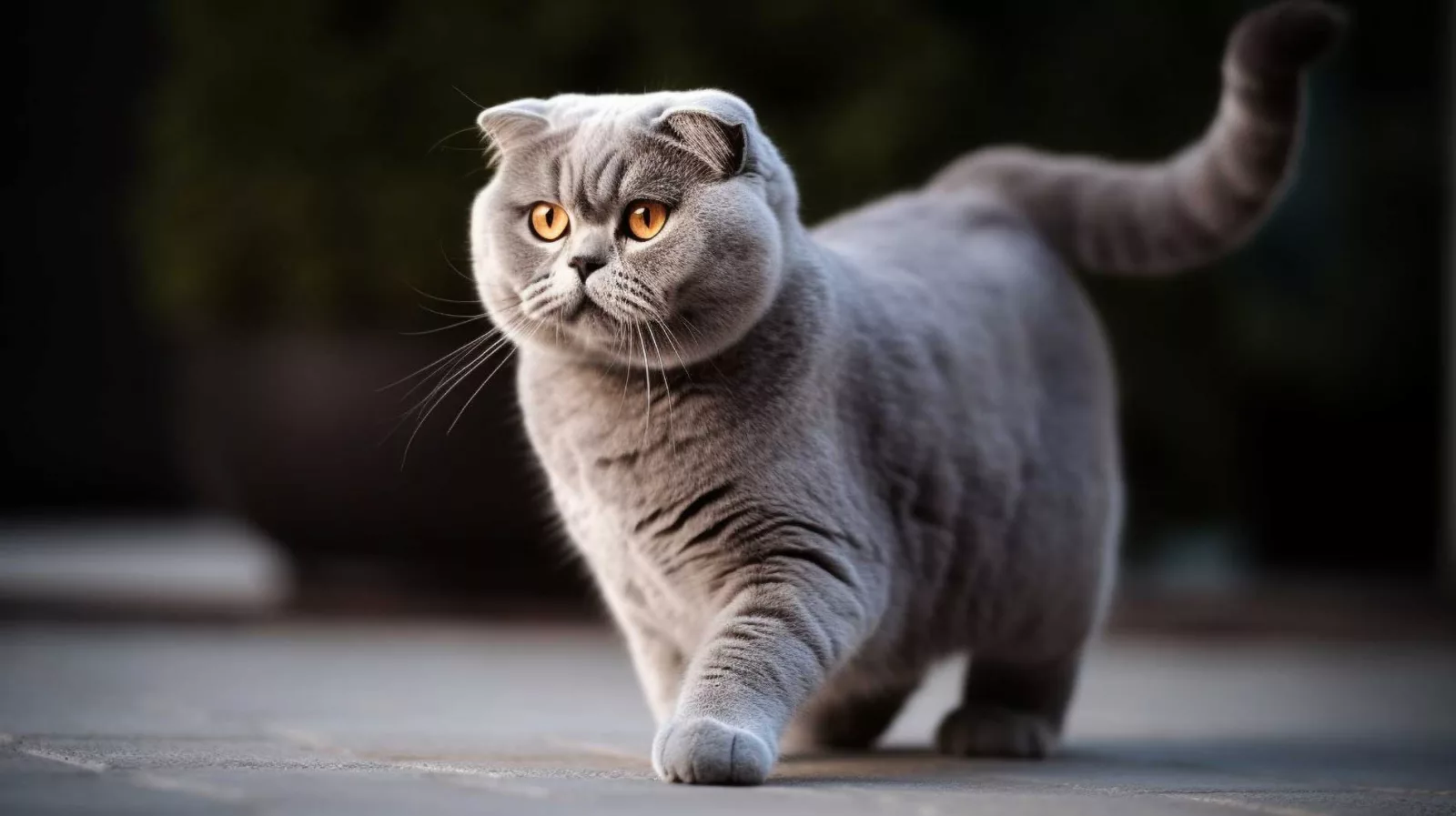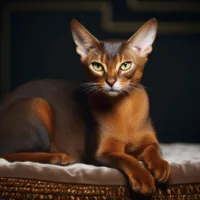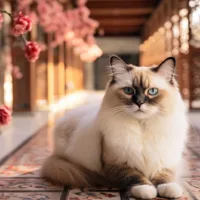Scottish Fold look & fur – fuzzy framed googly eyes
The most prominent feature of the Scottish Fold is the primary reason for the controversy surrounding the breed: her ears, which are folded forward and down. The Scottish Fold is considered one of the most ethically problematic breeds. That’s due to the hereditary condition responsible for the distinctive folded ears. The typical ears are a symptom of a disease! The scientific name for this type of disease is Osteochondrodysplasia (OCD). You can read more about it in the “Health” section.
At first glance, the Scottish Fold looks like a medium-sized British Shorthair with folded ears. But it is smaller and lighter. Friends of this breed describe it as looking like an owl or a teddy bear. Everything about the Scottish Fold’s head is round: her head, her more widely spaced eyes, her little muzzle. Her body is also rounded, almost chubby, and features short dense fur (there is also a long-hair variation). The neck is short, the tail only medium long. Her large round eyes give her an always astonished expression. To contribute to the overall impression of the round head, her ears should be as close to the head as possible, small in size and gently rounded. The ears may be folded one to three times.

The Scottish Fold’s coat is described as extending from the body and should be fluffy and not close-fitting. She does not require any special grooming. Once a week she may be combed, which will provide a little less fur fuzz on your furniture.
Where it is recognized, the Scottish Fold is bred in all colors.
Scottish Fold health – not all that glitters is gold
The most obvious health problem that every Scottish Fold actually has is the previously mentioned osteochondrodysplasia or OCD. The words “osteo” and “chondro” are derived from Greek and translate to “bone” and “cartilage”. Dysplasia describes a deviation from the norm. In the case of the Scottish Fold, this deviation causes severe cartilage abnormalities to develop throughout the cat’s body, resulting in painful arthritis and deformities.
Cats often exhibit lameness and swollen joints as well.
Animals suffering from this disease move as little as possible to minimize their suffering. Because when the cartilage hardens, the friction between bone and hardened tissue increases, which is extremely painful. In addition to their folded ears, which are still straight at birth and only fold down after three to four weeks, affected animals display an abnormal gait and deformed limbs. There is no treatment for this, nor is it possible to mitigate the condition, as may be claimed by unserious breeders or Scottish Fold fans. Research has shown: Whether both parents or only one parent has OCD, all Scottish Fold cats studied suffered from some degree of OCD.
People are wanting to have these cats because of that, but unfortunately it is another example of us prioritising how a pet looks rather than their quality of life.
Gudrun Ravetz to BBC Scotland
Prominent figures such as Gudrun Ravetz, President of the British Veterinary Association, and Rosemary Fisher from the Governing Council of the Cat Fancy (GCCF) have voiced concerns regarding the health struggles and quality of life for Scottish Folds. Fisher stated that they neither register nor permit Scottish Folds in their exhibitions.1 Our advice, therefore, is to never buy a Scottish Fold cat (they’re still bred and exported from the US).
If you come into possession of a Scottish Fold by other means, you must be careful not to allow mites to settle in because of her folded ears, and check the ears often for excess wax because they can become infected.
Aside from the severe and obvious problem due to OCD, the Scottish Fold is also prone to polycystic kidney disease (PKD) and hypertrophic cardiomyopathy (HCM). PKD causes enlarged kidneys. In old age, this can lead to kidney failure. HCM, in which the heart muscle thickens, cannot be cured, but if detected early, the prognosis is nevertheless good.



Scottish Fold diet – perfect balance of nutrients & moisture
Like all cats, Scottish Folds rely on meat for essential substances of animal origin that they cannot obtain from plant foods. Vital supplements such as taurine, minerals, and vitamins should be included as well as whole cuts of meat to be as close as possible to a cat’s natural diet. Filet pieces allow abrasion on the surface of the teeth, which cleans the teeth.
Likewise, the only species-appropriate type of diet for a cat is food containing a high level of moisture, since she absorbs needed fluids largely through eating. This stems from her African Wild Cat ancestry and her reduced thirst reflex. So, to flush the kidneys and bladder sufficiently, dry food should be eliminated from the diet of any cat.
Poor quality cat food often contains vegetable oil, which has no added value for cats. Fats should be of animal origin to be able to be metabolized. Salmon oil is particularly interesting for the Scottish Fold because of its anti-inflammatory effect. A useful supplement for cats with arthritis might be green-lipped mussel, which can be helpful for arthritis-related pain.2 A look at the list of ingredients will quickly show you: Good variety of high-quality food contains these important elements. For example, this Dynasty Emperor Ragout covers the needs of a cat in the most natural and generally animal-friendly way and contains all essential ingredients for cats. Consult with your trusted veterinarian here to optimize your Scottish Fold’s quality of life with the right nutrition.
Scottish Fold character – couch purr-tato pals
Basically, the Scottish Fold is active, social, and playful. But you have to keep in mind that this can turn into the opposite as soon as the OCD manifests itself. Then the Scottish Fold becomes very quiet and withdraws because it is permanently suffering from pain. However, since she naturally has a high activity level, this may lead to mood swings and behavioral problems. Some Scottish Folds do not like to be picked up, so it is thought that they are uncomfortable with it due to their condition.
The Scottish Fold is not particularly talkative or vocal. She gets along well with other cats but also with other species and is not particularly fond of being alone. So she will benefit from an animal companion when you are not around. Scottish Fold’s are also described as especially sweet and cute. You can often find photos of Scottish Fold cats sitting upright on their rear end or even dangling their legs. They are famous for sitting “oddly”. Sometimes this is explained by the fact that the breed is particularly flexible. We have not found any evidence for this, and OCD actually suggests the opposite. Also, Scottish Fold cats are said to be blessed with high intelligence and even like to solve puzzles.
Scottish Fold history – a twist of fate
As her name suggests, the Scottish Fold originates from Scotland. In 1961, on a farm in Coupar Angus, William Ross discovered two baby cats with folded ears in a litter of the cat Susie, a white cat with the same peculiarity. Ross and his wife felt these cats were so special that he asked the owner to let him take one of the kittens. Ross registered the Scottish Fold breed with the Governing Council of the Cat Fancy (GCCF) in the United Kingdom in 1966. Thereupon he started breeding.
Due to the aforementioned deformities and limitations caused by the hereditary disease from which Scottish Fold cats suffer, the GCCF banned the Scottish Fold from its list of cat breeds again in the 1970s. A descendant of Snooks, Susie’s daughter, was exported to the USA and then crossed with British Shorthair and American Shorthair cats, where the new breed achieved champion status with the CFA in 1970. Scottish Folds are still bred in America today by crossing them with British and American Shorthair cats. In Austria, breeding is punishable by fine or imprisonment. It is also supposed to be forbidden in the flemish part of Belgium. In Germany, there is a court decision from Bavaria that prohibits breeding, but the situation is unclear due to the situation in the different states.
Suitable for experienced cat owners with city apartment and full-time work
- Experience level: Experienced
- Housing: Apartment
- Activity level: Low
- Energy level: Medium
- Trainability: Medium
- Attachment: Medium
- Friendliness: High
- Playfulness: Medium
- Talkativeness: Low
- Intelligence: High







